
|
William Rockwell Clough |
1875-1879

1867 July 30 U.S. Patent No. 67,346, Stopper Fastener to C. Porter reissued to W.R. Clough in 1876
|
1875 April 6 U.S. Patent No. 161,755, Applied for March 17, 1875 |
 |
|
Small twisted wire medicine bottle corkscrew made from one piece of wire. This type had a square cut off on the button and a ground point. They were made by the partnership "Clough & Williamson" formed on June 1, 1877 and continued to be made by Williamson well after the partnership was absolved early in 1882. Examples with a square cut off button surface much less often than the later Crabb cut examples. The "Clough & Williamson" examples are identical to the later models made by Williamson. |
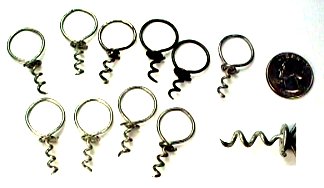 |
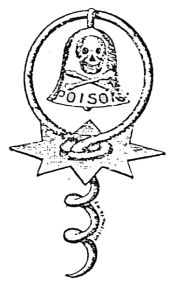 |
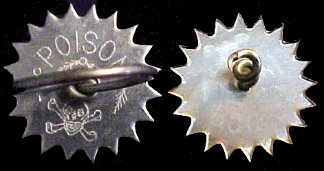 |
|
Clough corkscrews, with embellishments, were sometimes used to denote poison bottles. An article in the February, 1961 issue of The Spinning Wheel, reproduces an illustration (above left) from the October 6, 1890 Pharmaceutical Record for Bailey MFG. Co. showing a Clough corkscrew fitted with a bell and a spiked collar to indicate that the bottle contents were poison by sound and touch. A possible version of the Bailey (above right) with a similar spiked collar and marked POISON and a Skull & Crossbones, simply screwed on a Clough wire medicine corkscrew. |
|
|
Another possible version of a Bailey is this nickel plated welded assembly steel bell and clapper fitted with a scarf cut Clough helix. |
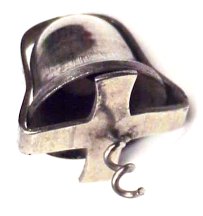 |
 |
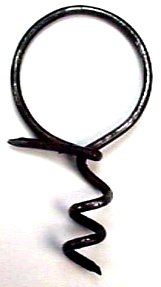 |
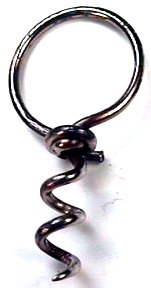 |
|
As these low cost wire corkscrews were made by the millions quality assurance and quality control may not have been a high priority. An example made with the ground point on the button and the square cut off on the helix point is shown above left. The short piece of pointed wire was simply placed in the treadle powered corkscrew manufacturing machine the wrong way around! At center is a Clough corkscrew with the scarf cut section, not folded around as usual to make a small button. Another Crabb cut Clough (above right) with the button not formed flat, but bulged out on the bottom, was possibly due to wire quality changes or perhaps a worn component in the machine. Not really a serious fault but one which tells the operator/overseer that something is amiss! I must point out it is quite rare to find an improperly made wire corkscrew manufactured by either Clough & Williamson, or Clough or Williamson! |
||
 |
1875 May 3 British Patent No.1640 - Medicine Corkscrew was granted to G. Haseltine, Patent Agent, for W.R. Clough for this same design. |
_______________

1876 February 1 U.S. Patent No. 172,868, Applied for November 1, 1875 - "Cork-Screw" (Wire Corkscrew) Granted to Clough while living in Newark, N.J. for a larger corkscrew made entirely of wire. This patent, used over many years, covered a variety of corkscrews of different sizes. All were basically made from a piece of wire with a point ground on one end and a square cut off on the other. Later, in conjunction with C.T. Williamson a wooden handle was added with a couple of turns around the handle. These were made in many varieties and sizes. The 1883 and 1887 C.T. Williamson Wire Novelty Co. catalogues illustrate 38 different versions of Clough's April 6, 1875 and February 1, 1876 patents.”
|
Corkscrews were also produced with two ground point double helixes from a single piece of wire.  |
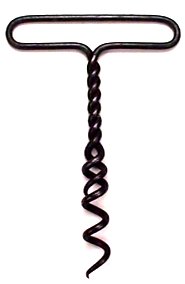 |
|
This corkscrew has a nickel-plated lead handle with a ground point wire helix and a square cut off button with the handle loop marked PATENTED FEB 1 1876. Also found unmarked, this lead handle was produced with a double wire helix marked with the patent date. |
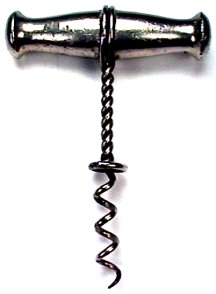 |
|
The well coveted, famous Williamson Power Cone with ebony handle, nickel plated fabricated steel frame and handle loop, is also marked PATENTED FEB 1 1876. Here a lead female socket provides the lifting action to remove the cork. Later examples with the same fabricated frame, have been found unmarked or marked WILLIAMSON'S, made after the dissolution of the CLOUGH & WILLIAMSON partnership. |
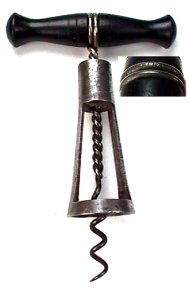 |
 |
Later the Williamson Power Cone corkscrew (left) was manufactured with a similar mechanical action and maple handle, but with a more rounded nickel-plated cast/forged steel frame and the handle ring marked WILLIAMSON'S or unmarked. (below) shows a comparison of the patent marked ebony Clough beside the later Williamson example. 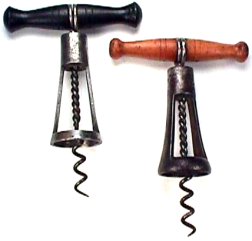 |
|
A wood handle and wire button (right) with the handle wire ring marked PATENTED FEB 1 1876 was a type manufactured by Williamson's for many years and is often marked WILLIAMSON'S. Also in the same catalogue is a combination nickel-plated steel hexagonal handle that is an ice pick, hammer and cigar box opener with a Clough wire helix corkscrew (below). |
 |
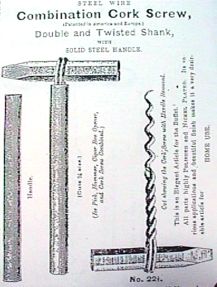 |
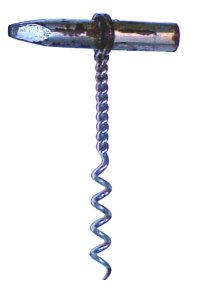 |
|
1876 Clough patent single finger double ring example manufactured by Williamson’s with a characteristic square button end and a ground point helix. Marked CLOUGH’S PATENT. |
 |
|
An early C.T. Williamson Wire Novelty Co. business envelope featuring a caricature of debonair Cornelius Titus Williamson depicted with a double wire helix torso holding a Duplex Power No. 136½ corkscrew with cherry handle. The envelope is completely covered in advertising highlighting Clough corkscrew patents, a Williamson’s bow and a number of hardware hooks made from wire. |
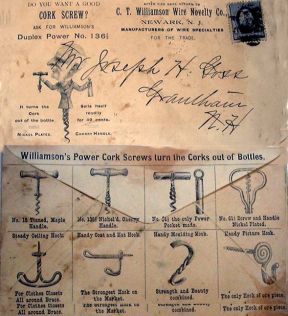 |
|
A folding C.T. Williamson Wire Novelty Co. trade brochure with identical advertising as the above envelope, once again with a caricature of Cornelius Titus Williamson illustrating 7 household hooks made of wire. |
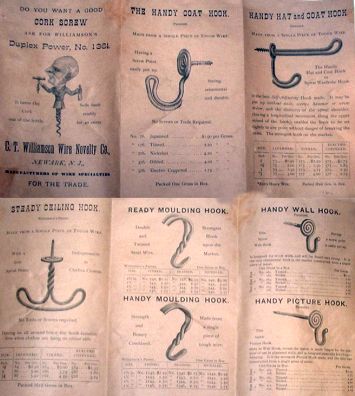 |
|
Identified as a Clough's Feb. 1, 1876 Patent Duplex Power Cork Screw with Champagne Opener in the C. T. Williamson’s 1883 Catalogue. |
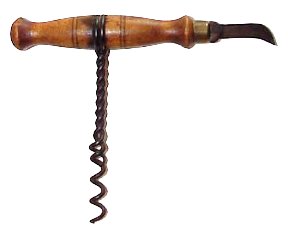 |
_______________

Above: A selection of various sized and different wire models after the February 1, 1876 Clough patent, manufactured by either Williamson or Clough. The example on the upper left is marked WILLIAMSON'S, the next with the partially twisted shaft is advertising MARYLAND CLUB RYE with the last erroneously marked PAT APR 6 75, when in fact it is an 1876 patent example.

A wide range of nickel plated pocket corkscrews illustrated in an 1883 C.T. Williamson catalogue including double wire and left hand examples.
_______________
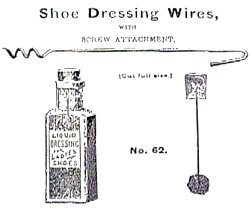 |
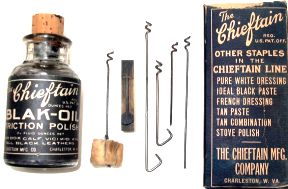 |
|
Another unusual wire helix in the 1883 catalogue, possibly initiated by Clough, was a Shoe Dressing Wire with a wire helix to hold a bottle cork from the underside. Shown here with four unused dressing wires from Williamson stock and a printing block used in the catalogue. - The BLAK-OIL Friction Polish was made by the Chieftain Manufacturing Company, Charleston, West Virginia. |
|
|
Another bottle from Chieftain: Black French Shoe Dressing for Ladies and Childrens Shoes. |
 |
_______________
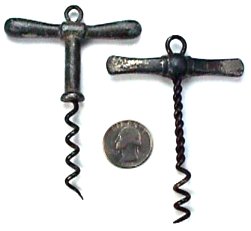 |
Two small (2 7/8”7.4cm high) cast lead (traces of original nickel plating) handle corkscrews by C.T. Williamson that are a twisted wire form definitely influenced by Clough. The one on the left is illustrated in 1883 & 1887 C.T. Williamson catalogues and is sometimes attributed to the 1882 Barnes Patent made by Williamson’ as it has a Barnes patent type lead handle. On the right is another early example also by Williamson‘s with a flat lead handle with a similar Clough inspired wire helix. |
_______________
 |
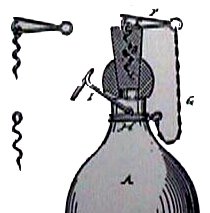 |
|
1876 December 12 Reissue of U.S. Patent No. 67,346, July 30, 1867 "Corking Bottles" (left) by Charles H. Porter, Albany, New York as No. 7,424 (right) with name changed to "Bottle Stopper Fastener" was assigned to W.R. Clough, applied for August 7, 1876. The reissue contains three additional claims, which do not change the invention in any way, but presumably strengthened the patent protection. One of the reissue witnesses was Charles Gill, who later became a patent attorney for Clough. |
|
_______________
 |
1877 September 15 German Patent No. 977 "Pfropfenzieher" Combination of 1875 and 1876 U.S. Clough Patents granted to James M. Maconnell, Hamburg, Germany for a combination of both Clough's 1875 and 1876 corkscrew patents. This was the beginning of a long-standing relationship between Clough & Maconnell. |
_______________
|
1878 October 2 British Patent No. 3868 "Improvements in Corkscrews and in Machinery for Making the Same" (Corkscrew Machine) was issued to E.P. Alexander, Patent Agent for W.R. Clough, Newark, New Jersey for a Corkscrew Manufacturing Machine. One, or several pieces, of wire were first cut to length, pointed and placed in a slide on the machine which formed the corkscrew. This particular machine was never patented in the United States. |
 |
_______________
 |
An illustration of a Clough type open wire "T" handle corkscrew was shown in a March 1880 issue of The Scientific Canadian which stated that Messrs. Nettlefolds, a well-known screw and wire manufacturer of Birmingham, had introduced a novel corkscrew designated as "A Cheap Corkscrew" and "Everybody's Corkscrew" (Note the English definition of "cheap" meaning well made at a low cost, not poor quality). The illustration depicts, what appears to be an exact copy of a Clough 1876 patent corkscrew. It is possible that Nettlefolds was a manufacturer of Clough corkscrews in Great Britain, especially after the October 2, 1878 English Corkscrew Manufacturing Machine patent. |
_______________
 |
Print entitled Wire Corkscrews Manufactured by Nettlefolds in 1923 - All corkscrews appear identical to earlier Clough/Williamson’s examples of the late 19th century |
_______________
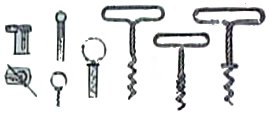 |
|
1878 November 25 French Patent No. 126,098, Applied for August 13, 1878 "Fabrication des Tire-Bouchons" (Corkscrew Machine) granted to W.R. Clough for a Corkscrew Manufacturing Machine similar to the 1878 English Patent, to make wire finger and wire "T" handled corkscrews. A silver medal was awarded to Clough & Maconnell for this design at the 1878 Paris Exposition. |
_______________

This is a good place to point out that French Patent No 131825, was granted to Leon Paillard September 30, 1879 for twisted wire "automatique corkscrews" illustrated in 10 different styles, all with a wire spring barrel. This very interesting corkscrew design, as far as I know, has yet to be found and has not appeared in any books, articles or publications to date, including Best Six information and newsletters from various corkscrew collecting clubs including Club Français de Tire-Bouchon (CFTB), Canadian Corkscrew Collectors Club (CCCC), International Correspondence of Corkscrew Addicts (ICCA) and the German club Verein Korknzieherfreunde.
©2002, 2003 Ron MacLean
Book Designer and Webmaster: Donald A. Bull